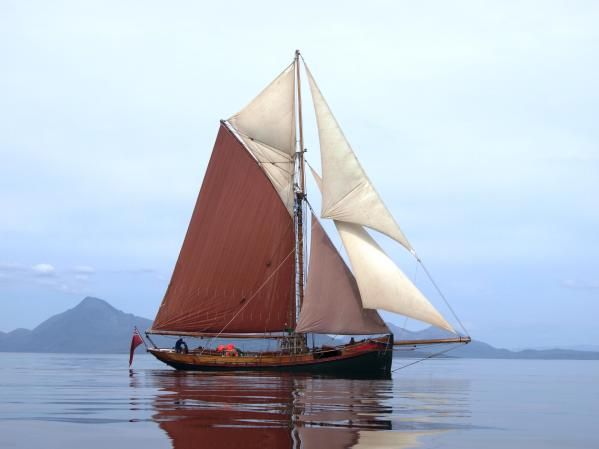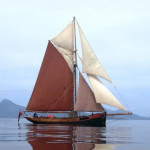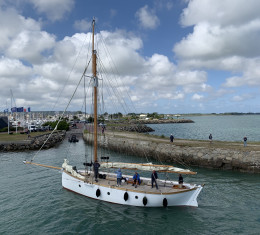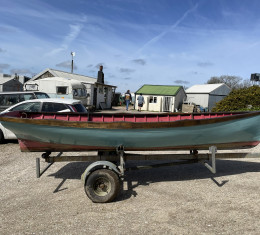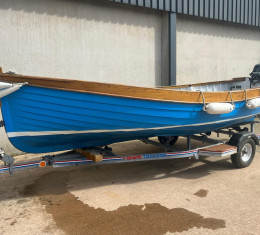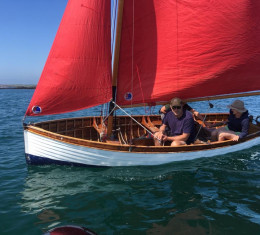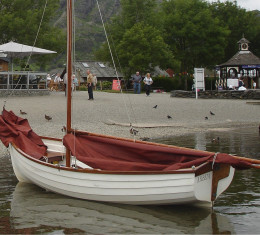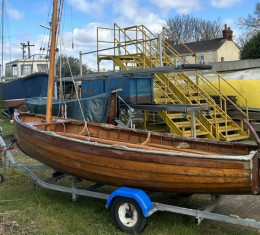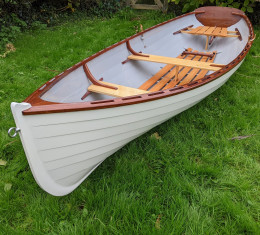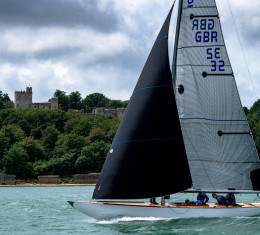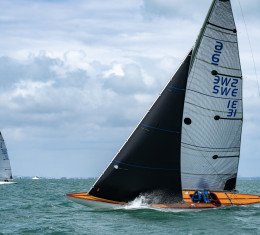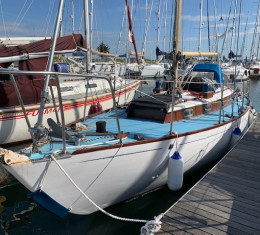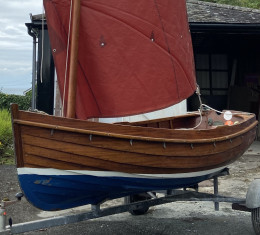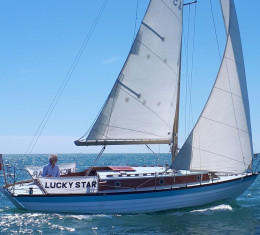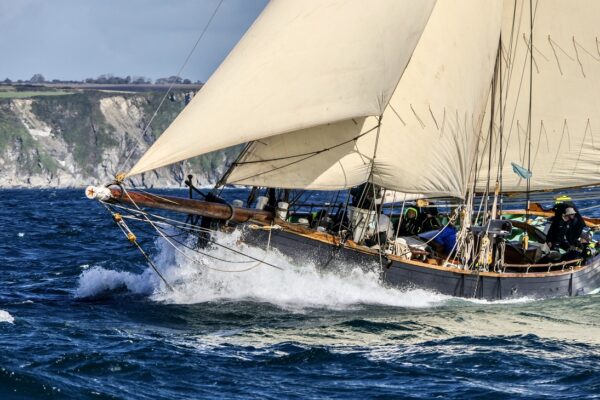Sailing yachts
Full specification
Wooden ships comments on this 53′ Charter gaff cutter
Converted charter gaff cutter. Built by Grenna Shipyard, Denmark in 1939 as a fishing boat. She was decommissioned in the mid-eighties, bought by the present family owners and moved to Scotland where she underwent a major refit for charter work.
While ashore in 1993 she was badly damaged by a fire which necessitated a major rebuild. This work involved replanking all of the port side and half the starboard side. Any original planking remaining was refastened.
The deck was replaced on new beam shelf, new deck beams, new stanchions and bulwarks. She was fitted out below for charter and rigged as a gaff cutter.
The work took 3 years and she was launched again in 1996.
Since relaunch, she has worked consistently and very successfully as a charter yacht cruising extensively around Europe including visits to Spain, Portugal, Norway, Sweden and Denmark, Estonia and Russia.
In 2002 she crossed to the Caribbean winning the Concourse d’Elegance prize in the Antigua Classic that season.
These Danish fishing boats known as Haj Kutters are descended directly for the earlier fishing boats which worked under sail. These boats are massively built in oak with a bluff bow, a very pretty counter stern with a sweet sheer and the working boats carried a gaff ketch rig.
The decision to rig her as a gaff cutter with a large sail area on a tall mast has been amply rewarded by her excellent performance. She has regularly proved faster than the similar Luke Powell pilot cutter types currently working on the West coast of Scotland, she has performed well in 4 Tall Ships Races and comes into her own in strong winds when she gives huge confidence in her strength, reliability and sea-worthiness.
In his report dated August 1995 when the rebuild work was well progressed, the surveyor commented “The quality of work generally is exceptional” and “the quality of materials is the best”. He draws attention to the exquisite detailed work of carving and beading around the hatches and beams and adds “we have to say that we have seldom seen craftsmanship to this standard”.
The cutter has a Cat 2 (60 miles from Safe Haven) Code of Practice Certificate with Cat 0 (world-wide) stability for 14 persons on board, last certificate dated April 2011 and valid for 5 years. Subject to annual survey. The vessel is equipped in excess of the Code requirements
NB. Code of Practice certification expires on sale and must be renewed in new ownership.
This cutter presents an exceptional opportunity to buy a very successful and totally proven ship with a track record of charter earnings. Alternatively, she is of a size and versatility to be a viable and manageable private or family yacht.
The vessel was originally planked in oak. Due to the fire damage much of the planking had to be replaced and the exact areas are defined in a survey dated August 1995, copy available. New planking has been fitted in 2” larch, caulked and payed.
Fastenings are 6” galvanised boat nails, all new in the 1993 rebuild, remaining original oak planking refastened.
Frames are sawn oak, 6” x 4” in pairs with 4” between. The Danish method of building pins the pairs of frames together with ½” galvanised rod but leaving a 1” gap which avoids wet rot between the pairs. There is more frame than space!
The stringers have been largely replaced.
Oak back-bone with a 2 ton steel shoe. The frames overlap across the back-bone to form the floors. The back-bone is through bolted with 20mm galvanised steel bolts, all new in 1996.
Ballast is approx 19 tons concrete mixed with pig iron. This is the original method of ballasting these fishing boats, the ballast cannot move, it gives a flat floor in the fish hold and adds to the strength of the back-bone. Contrary to popular opinion it is very rare to get trouble under the concrete with the whole area soaked in fish oil.
The deck is built in 2 ½ ” Oregon pine, quarter sawn, caulked and payed.
The bulwarks are carried on 4” x 4” oak stanchion posts through the coverboards with a wide, varnished iroko capping rail all round. A few original stanchion posts remain, most have been replaced.
The larch bulwark planking has a bead along each edge, the lower board is mahogany. A 1” gap all round the bottom edge frees water from the deck and waterways are opened in the bulwarks planking at the waist.
The bulwark planking round the fan tail counter is laid vertically to very good effect.
The high bulwarks give great security around the extensive clear deck space and the casings afford secure seating on deck.
The new deck lay-out has a pair of bitts forward to carry the bowsprit heel with a windlass ahead to stbd.
Aft of the bitts is the fore hatch, just off-centre to stbd.
Main mast stepped through the deck onto the keel.
Immediately aft of the main mast is the midships low-level casing with sliding hatch entrance to the cabin, all beautifully made in varnished Burma teak coamings, scrubbed pine deck with varnished teak margin boards and sliding hatch. This casing is also a good sitting area.
Aft again is the nav station dog-house with entrance to the aft cabin, hip height with a starboard off-set entrance hatch, also all built in varnished Burma teak. Windows each side have protection bars.
The navigation post with chart desk and instruments are sited here, close to the helm and readily available yet fully sheltered and protected from the elements. Ladder to below.
Aft again is the helm position, a varnished teak box enclosing the steering worm drive mechanism on top of the rudder stock with a traditional teak spoked wheel, the vessel’s name carved round the rim and a leathered saddle on the lid of the box, rather eccentrically allowing the helmsman to sit astride!
The extensive use of varnished teak and oak, varnished pine spars and scrubbed deck give the vessel the appearance more of a yacht than a working boat and it is unlikely the original fisherman owners would ever recognise her.
Gaff cutter rig setting approx 1500 sq’ working sail in mainsail, staysail and jib. In addition she sets a gaff tops’l over the main and a jib tops’l.
The Douglas fir main lower mast is stepped on the keel and stands 35’ above the deck.
The 30’ spruce fidded topmast takes the overall mast height, deck to truck to a little over 60’
The bowsprit is set running to port of the stem, the heel lodged between twin bitts and extends 17’ forward of the stem.
The varnished spruce main boom is 33’ and reaches out exactly to the end of the taff rail aft.
The boom is fitted with slab reefing with combs each side aft to take the reefing pennants with a 4-part main sheet tackle on varnished wooden blocks to a traditional “shock absorber” horse on the after deck, the tails led to cavil bars each side aft.
The 29’ varnished spruce gaff is fitted with a leathered galvanised saddle.
Main mast shrouds, 3 per side in 16mm galvanised steel wire fully served rattled up both sides, leathered eyes round the mast set up to 25mm galvanised rigging screws to external galvanised chain plates.
Cap shrouds in 12mm stainless steel wire made up to lignum vitae deadeyes and lanyards.
The topmast forestay turns through a block on the outer end f the bowsprit and is made up to a 5 part tackles to the bitts.
Mainmast fore stay, hounds to stemhead in 20mm galvanised wire through the stem fitting and set up with a 25mm galvanised rigging screw.
Top mast running back-stays in 12mm galvanised wire made up to 5 part tackles. (takes the jib tops’l on hanks)
Main mast running back-stays in 16mm galvanised wire to a steel block with stainless steel pennants to Highfield levers on the deck.
Bobstay in 12mm chain with tackle bowsed down on the windlass.
100mm stainless steel whisker stays with 4 part tackles.
The jib is set flying from the hounds and runs out the bowsprit on a traveller.
Sails by Jimmy Lawrence, Essex.
Mainsail 1000sq’ 2008
Staysail 280sq’ 2002
Large Jib 330sq’ 2002
Tops’l 300 sq’ 2002
Jib Tops’l 300 sq’ 2002
No 2 jib 250sq’ 1996
Storm Jib 1996
Trysail 1996
Machinery
Kelvin R6 112hp 6-cyl diesel engine built 1969, rebuilt 1996.
New rings, liners, main and big end bearings in 2006
Kelvin 3.33:1 close-coupled gear box with single lever controls.
Centre-line installation to Hundested 48” fully feathering 3-blade prop.
Cruising speed 6.5knts. @ 6.5 lph Max 7.8knts @ 15lph.
Electrics.
24v electrical circuits with 6 x 12v 220 amp/hr batteries.
Balmar 70 amp engine driven alternator.
Shore power connection
Victron 100 amp 240v battery charger on shore power connection or on the generator.
Perkins 5.5kva diesel generator in the engine room.
Tanks:
2000 litres diesel in 2 steel tanks, either side of the engine room.
1600 litres in 2 stainless steel tanks, one under the saloon table, one each side under the saloon cabin seats.
Waste tank. Fitted but not plumbed in.
2 x Separ Duplex fuel filters.
Water supply.
Pressurised water system with 24v pump and digital water consumption meter.
Water is heated by the engine cooling water through a calorifier tank or by 240v immersion heater in the calorifier tank.
Accommodation.
13 berths in total – 2 twin forward cabins, 2 twin quarter cabins, 2 pilot berths in the saloon cabin and 3 berths in the aft cabin.
The interior is divided into 4 separate spaces – see attached plan.
Right up in the bows is a small Bosun’s cabin/store.
Center-line door to central lobby, bitts come down in the middle of this lobby space with the ladder from the fore hatch against the lobby aft bulkhead.
Port and stbd cabins off the lobby, both with up and down berths, partially closed off by partitions off the forward bulkhead with the door apertures closed by a curtain.
Passage aft to port with the heads compartment to port and a shower compartment on the cewntre-line, both compartments with sea toilets and hand basins.
Blake sea toilets with 24v pumps to overboard discharge (not yet plumbed into the waste tank)
Handbasins and shower all drain overboard.
The passage opens to the main saloon cabin
Galley on the starboard side, open to the saloon cabin in the forward starboard corner.
Canon twin oven and 4-burner stainless steel gas cooker against the fwd bulkhead.
Stainless sink and work surface down the starboard side of the ship. Pan stowage under.
H&C and sea water supply to the sink, drains overboard.
Original Danish cast iron single gas burner.
The main saloon cabin is dominated by a large miracle table in the middle with bench seating down either side and the midships casing over.
The table contains one of the 3 water tanks, the mast passes through the forward end, leaves lift each side for meal times and an extension piece, stowed against the after end can be fitted to extend the length of the table aft.
The table also contains a 160 litre freezer and a 160 litre fridge, both powered by Isotherm Magnum twin water-cooled 24v compressors.
Up behind the seats is an occasional pilot berth each side under the side decks with curtains as in the old fishing boats. These pilot berths are small and usually used for storage on longer passages.
At the forward ends, port and stbd, are storage lockers with deep shelves providing the extensive storage required for galley stores for longer passages.
Aft midships is the main companionway to deck.
To either side are port and stbd quarter cabins, each with up and down berths and curtains across the doorways.
The engine compartment is in the middle behind the companionway ladder. Access to the engine room is by a companionway and door from the nav station dog-house.
An aft cabin is accessed by a companionway ladder from the after nav station dog-house. Port and stbd berths with a small athwartships berth across the after end.
Drying radiator heated by the engine cooling water – essential in her Scottish home waters.
Diesel fired hot air cabin heater with flue to deck.
Head-room 6’6” under the midships coach-roof.
5’10” elsewhere
Equipment.
Navigation
Sestral Major steering compass by the helm.
Raymarine sounder with deck repeater
Trailing log
Garmin radar, new 2011
Furuno GPS
Garmin chart plotter
PC with Sea Pro 3000 Plus navigation software.
Class B AIS
Icom M600 SSB radio
Icom DSC VHF radio
Safety gear.
Viking Solas B 16 man life raft, last service April 2011
16 inflatable life jackets
Ring life buoy
Inflatable Danbuoy
Numerous flares
Numerous fire extinguishers as required by Code of Practice including engine room sprinkler system and fire alarm system.
Ground tackle
100kg fisherman anchor
50 kg fisherman anchor
40kg CQR anchor
Hydraulic windlass
100 meters 12.5mm chain
Numerous warps
Deck gear.
4.5m Humber inflatable dinghy
Yamaha 15hp 2-stroke outboard engine, 2008
4 x 32mm mooring warps.
4 large fenders.
Other gear.
Full galley equipment.
4 sets of berth linen
Large quantity of world charts and pilot books
Numerous engine spares including pistons, liners, cylinder head, fuel pump etc.
Stability booklet including line drawings, GZ curves, KN data and inclining reports.
In certain circumstances and subject to conditions, various commercial data including accounts, mailing lists, web site and promotional material will be included in the sale.
Disclaimer:
These particulars have been prepared in good faith from information provided by the Vendors and are intended as a guide, Wooden Ships cannot guarantee or warrant the accuracy of this information nor warrant the condition of the vessel. The Purchaser should instruct his agent or surveyor to validate all details as necessary and satisfy himself with the condition of the vessel and its equipment.
Wooden Ships classic yachts brokers have an extensive database of boats for sale. With a wide range of sailboats, classic yachts, motor yachts and small classic boats, Wooden Ships has one of the largest selections of traditional wooden boats and yachts for sale in the UK.
Disclaimer:
These particulars have been prepared in good faith from information provided by the Vendors and are intended as a guide, Wooden Ships cannot guarantee or warrant the accuracy of this information nor warrant the condition of the vessel. The Purchaser should instruct his agent or surveyor to validate all details as necessary and satisfy himself with the condition of the vessel and its equipment.

